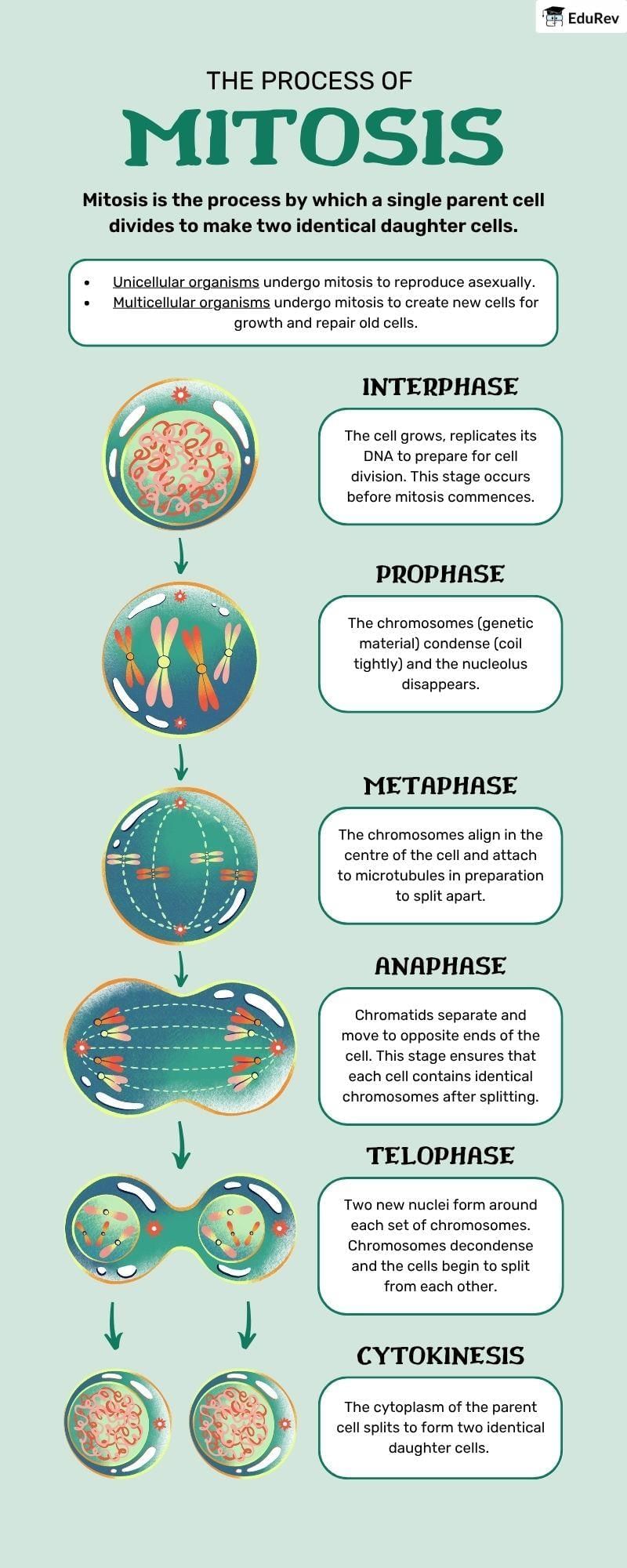NEET Exam > NEET Notes > Biology Class 11 > Infographics: Process of Mitosis
Infographics: Process of Mitosis | Biology Class 11 - NEET PDF Download

The document Infographics: Process of Mitosis | Biology Class 11 - NEET is a part of the NEET Course Biology Class 11.
All you need of NEET at this link: NEET
|
150 videos|401 docs|136 tests
|
FAQs on Infographics: Process of Mitosis - Biology Class 11 - NEET
| 1. What is mitosis and why is it important in cell division? |  |
Ans. Mitosis is a type of cell division that results in two genetically identical daughter cells, each having the same number of chromosomes as the parent cell. It is crucial for growth, development, and tissue repair in multicellular organisms. Mitosis ensures that when a cell divides, the genetic material is accurately replicated and distributed, maintaining the integrity of the organism's genetic information.
| 2. What are the main phases of mitosis? |  |
Ans. Mitosis consists of several distinct phases: prophase, metaphase, anaphase, and telophase. In prophase, the chromatin condenses into visible chromosomes, and the nuclear envelope begins to break down. During metaphase, chromosomes align at the cell's equatorial plane. Anaphase follows, where sister chromatids are pulled apart to opposite poles of the cell. Finally, in telophase, new nuclear membranes form around each set of separated chromosomes, and the cell prepares to divide.
| 3. How does mitosis differ from meiosis? |  |
Ans. Mitosis and meiosis are both processes of cell division, but they serve different purposes. Mitosis results in two diploid daughter cells that are genetically identical to the parent cell, while meiosis produces four haploid gametes with half the number of chromosomes, introducing genetic diversity through recombination and independent assortment. Mitosis is primarily involved in growth and repair, whereas meiosis is essential for sexual reproduction.
| 4. What role do spindle fibers play during mitosis? |  |
Ans. Spindle fibers are crucial structures that form during mitosis. They are composed of microtubules and are responsible for separating the sister chromatids during anaphase. Spindle fibers attach to the centromeres of chromosomes and help pull them apart, ensuring that each daughter cell receives an accurate copy of the genetic material. Proper functioning of spindle fibers is essential for successful cell division.
| 5. What are the potential consequences of errors during mitosis? |  |
Ans. Errors during mitosis can lead to various consequences, including aneuploidy, where cells have an abnormal number of chromosomes. This can result in developmental disorders or contribute to the progression of diseases like cancer. Misregulated mitosis can lead to uncontrolled cell growth, resulting in tumors. Therefore, accurate mitosis is essential to maintaining healthy cellular function and organismal development.
Related Searches
















